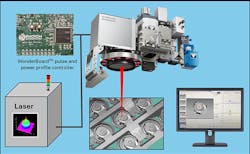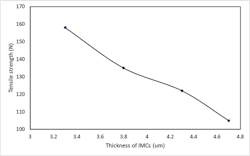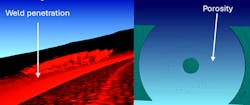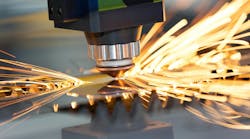Cylindrical Li-ion module interconnect strength increases via laser welding
Cylindrical lithium-ion (Li-ion) cells—such as 18650, 21700, and the larger 4680 format—are widely used within portable electronics, power tools, energy storage systems, and especially electric vehicles (EVs) because of their high energy density, standardized design, and proven reliability. These cells often use Hilumin (nickel-plated steel) because the can material provides corrosion resistance from the nickel plating and structural strength from the steel to handle internal pressure and mechanical stress. Some 46-mm-diameter cylindrical cells are made from different materials, such as aluminum and Hilumin, to meet specific design and performance requirements. When welding aluminum to steel, a key challenge in module or pack manufacturing arises from the differences in thermal properties and material behavior during laser joining.
Constructing cylindrical battery modules or packs involves arranging the cells in organized rows and connecting these cells in parallel or in series—depending on the voltage and current requirements of the application. This configuration allows manufacturers to tailor the pack’s overall energy capacity and power delivery to match specific system needs, such as electric vehicles or stationary energy storage systems. The cells are typically interconnected using aluminum busbars ranging from 0.3 to 0.6 mm in thickness, which are then laser welded to provide reliable electrical connections (see Fig. 1). The Hilumin used for the cell structure often has a different thickness, ~0.4 to 0.6 mm, depending on the cell design and manufacturer.
For electric vehicle applications, the welds connecting aluminum busbars to these battery cells must maintain high structural integrity and conductivity under harsh dynamic conditions, including shock, vibration, and thermal cycling, which makes precise and reliable laser welding essential for long-term performance and safety. Laser welding is a good fit for these assemblies because it creates strong, clean joints with low heat and minimal distortion. It’s especially important because one of the main challenges in assembling these modules is welding aluminum to Hilumin.
Formation of brittle intermetallic compounds (IMCs)
The first challenge during this process is the formation of brittle IMCs, which significantly reduce both strength and conductivity. This issue arises from the differing properties of aluminum and steel, particularly their response to heat. Aluminum melts and expands faster than steel, which creates thermal stress and promotes the growth of IMCs during welding. These IMCs, such as iron aluminides FeAl3 and Fe2Al5, are typically brittle and can weaken the joint, which causes cracks, reduces strength, and increases corrosion.
Formation and total volume of IMCs during welding are critical to weld quality and long-term performance. As IMC volume increases, joints become more brittle, which reduces mechanical strength and increases the likelihood of failure under stress. Deeper weld penetration typically increases the total IMC volume and underscores the need for precise control of welding parameters to ensure strong, reliable, and durable joints.
Extensive studies have shown maintaining thin, uniform IMC layers—typically ~2 to 10 µm—yields higher tensile shear strength. These thin layers enable effective metallurgical bonding while minimizing brittleness in the joint. But thicker IMC layers—that exceed 15 µm—often reduce tensile strength because their brittle nature encourages crack initiation and propagation under load (see Fig. 2).
To address this, a more effective approach is to expand the welding interface area rather than rely solely on deep penetration. Increasing the interface area enhances metallurgical bonding but limits the overall IMC volume, which reduces brittleness and distributes stress more evenly across the joint for improved reliability. This can be achieved via a combination of laser pulsing and beam scanning techniques to enable precise control of heat input and interface formation and minimize IMC growth.
Photon Automation has engineered an advanced pulse and power profile controller that operates lasers with microsecond precision for tailored pulse shaping. By fine-tuning the pulse shape, it helps lower localized thermal stresses, which preserves the desired mechanical characteristics of the material, reduces the size of the heat-affected zone (HAZ), and enhances part longevity. Our WonderBOARD also interfaces with the galvanometer controller to evenly distribute laser energy across the workpiece to prevent hot spots and inconsistent heating caused by rapid beam motion.
Laser pulsing and beam oscillation to control IMC formation
Pulsed lasers allow for better control overheat input and reduce the risk of excessive melting or spatter. They enable cooling periods between pulses, which minimizes thermal buildup and helps prevent defects like burn-through or distortion. Pulsing also improves weld pool stability, especially when welding thin materials or dissimilar metals like aluminum and steel.
By dynamically oscillating the laser beam across the weld area (often using galvo mirrors), energy is evenly distributed. This avoids edge effects, which occur when the laser beam lingers too long at the start or end of the weld path, which can lead to overpenetration, notches, or hotspots. Oscillating also enables customized weld shapes (circular, spiral, or zigzag), which enhances the mechanical strength and uniformity of the joint.
Combined pulsing and oscillating create a highly controlled welding environment where thermal gradients are minimized, metallurgical bonding is optimized, and stress is distributed more evenly. This approach is especially valuable in battery manufacturing, where precise energy control is needed to avoid damaging sensitive components or insulation zones.
A second challenge is to achieve precise weld placement and consistent welding quality.
For cylindrical cell designs, both the positive and negative terminals are located on the top surface, with the central electrode cap acting as the positive terminal and the surrounding ring serving as the negative. This shared layout limits the available weld area and demands extremely accurate laser positioning. Even slight misalignment can lead to weak welds, internal damage, or short circuits, which increases the risk of cell failure or, in severe cases, thermal runaway.
During assembly, these modules often contain hundreds of tightly packed cells. Even small height variations between cells caused by manufacturing tolerances or handling can lead to uneven contact with the busbar or welding tool. This inconsistency results in variable weld quality, poor electrical connections, and long-term performance issues if not properly addressed.
To overcome these challenges, manufacturers rely on two core systems: Vision system and optical coherence tomography (OCT).
Vision systems detect and locate the positive terminal (center cap) and negative terminal (outer ring/rim) of each cylindrical cell. They also compensate for cell-to-cell variation/tolerances and fixture misalignment, and guide the laser to ensure proper weld positioning, avoiding contact with insulation or edge zones. This enables consistent, high-precision welds across modules with hundreds of cells.
OCT measures the height of each cell before welding to detect even the slightest variations. It dynamically adjusts the laser focal position using a motorized collimation lens, ensures the laser remains focused on the exact weld plane, improving weld quality, and enhances reliability for automated production environments where cell height can vary slightly across the module.
Welding process monitoring and data acquisition are a foundation for AI
Implementing laser weld monitoring (LWM) systems is a critical step toward enabling AI-driven process control. During the laser material interaction, energy signals are emitted in various forms: Plasma radiation (ultraviolet wavelength), thermal emission (infrared wavelength), back reflection (actual laser wavelength), and monitoring of laser power passing through the optics. Each of these signals contains valuable information about the welding process parameters.
Photodiode-based sensors capture these emissions in real time and compare them to reference data collected from good welds. This continuous data acquisition helps identify defects such as lack of fusion, missing welds, or inconsistent penetration. Over time, the accumulation of high-resolution process data provides a foundation for training AI models, which can detect patterns, predict failures, and enable closed-loop process optimization.
Process development validation for welding quality
During laser welding of cylindrical Li-ion batteries, ensuring internal weld integrity is critical for safety and performance. Special attention must be given to the safety of any plastic or rubber materials beneath the top surface during welding. Excessive heat, improper laser parameters, or excessively deep penetration can damage underlying insulation or structural components made of plastic or rubber, leading to short circuits, leakage, mechanical failure, or thermal runaway.
Computed tomography (CT) enables nondestructive, high-resolution inspection of welded joints, which provides 2D and 3D data that reveal internal defects such as voids, penetration nonuniformity along the weld interface, or insufficient penetration depth (see Fig. 3). This 3D CT data supports process development by validating weld quality and identifying areas where penetration did reach sealing or insulation materials, which helps prevent such issues during production.
REFERENCE
1. H. He et al., Coatings, 14, 10, 1262 (2024); https://doi.org/10.3390/coatings14101262.
Related Webinar
About the Author
Najah George
Najah George is senior director of R&D at Photon Automation (Greenfield, IN).
William A. Huffman Jr.
William A. Huffman Jr. is CEO at Photon Automation (Greenfield, IN).
Sebastian Moser
Sebastian Moser is CEO & president of Precitec USA (Wixom, MI).



